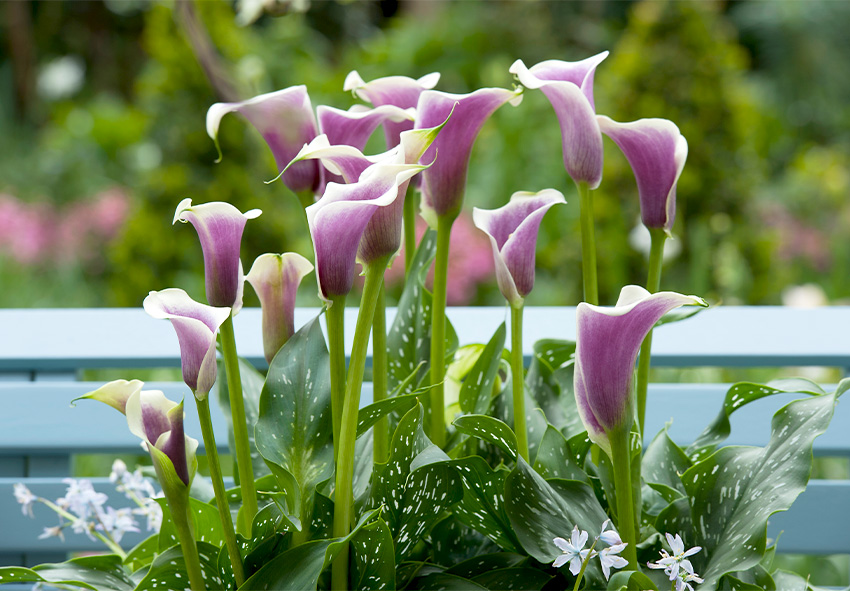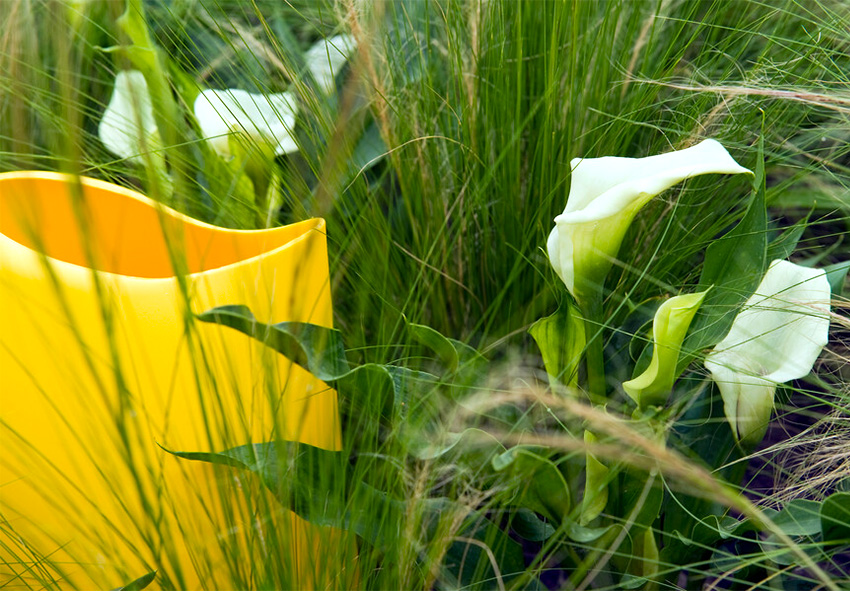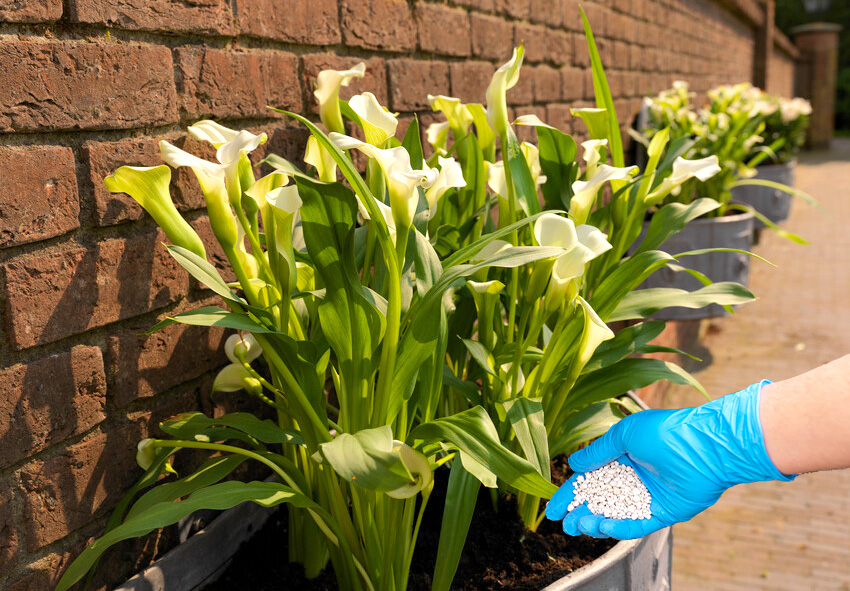Calla lilies are beloved for their elegant, trumpet-shaped blooms and lush green foliage. Whether you’re growing them in beds or containers, understanding how to care for calla lilies through the seasons is crucial for vibrant flowers and healthy plants. In this guide, we’ll cover year-round care tips for both hardy and tender calla lily varieties to ensure they thrive in your garden. Our gardening blog is a perfect place to find all the information you need!
Spring Care for Calla Lilies

Spring is the start of the active growing season for calla lilies. This is when you prepare the soil, plant new rhizomes, and give your plants the boost they need to begin healthy development. Proper spring maintenance lays the foundation for a successful bloom season.
Preparing Soil and Beds
Before planting, make sure the soil is rich in organic matter and drains well. Calla lilies prefer slightly acidic to neutral soil and thrive in locations that receive partial to full sun. Adding compost or aged manure helps improve fertility and structure.
Planting and Spacing
Proper planting depth and spacing are essential for healthy calla lily growth and to prevent overcrowding, which can lead to poor air circulation and disease. Follow these guidelines to ensure your calla lilies thrive from the start:
- Planting Depth: Bury calla lily rhizomes 3–4 inches (7–10 cm) deep, with the growing points or “eyes” facing upwards.
- Spacing Between Plants: Space rhizomes about 12 inches (30 cm) apart to allow room for mature foliage and flower stalks to spread.
- Soil Preparation: Use well-draining, rich soil amended with compost to support root development and moisture retention.
- Water Thoroughly After Planting: Once planted, water deeply to help settle the soil and initiate root growth.
- Choose a Sunny or Lightly Shaded Spot: Ensure the planting location receives at least 6 hours of sunlight daily for optimal blooming.
Early Fertilization
Once planted, feed your calla bulbs with a balanced slow-release fertilizer to jumpstart growth. A 10-10-10 or 5-10-5 mix works well. Water thoroughly after fertilizing to help nutrients reach the roots.
Summer Maintenance
Summer is the peak blooming period for calla lilies. Consistent moisture, pest monitoring, and flower support are key to keeping your plants healthy and beautiful throughout this season.
Watering and Mulching
Calla lilies enjoy moist—but not soggy—soil. Water regularly, especially during hot spells, and apply mulch around the base to help retain moisture and regulate soil temperature. Mulch also suppresses weed growth, which can compete for nutrients.
Pest and Disease Monitoring
Regular observation and early detection are key to keeping your calla lilies healthy throughout the growing season. Use this checklist to monitor and manage common threats:
- Inspect Weekly for Insects: Check leaves and stems for common pests like aphids, spider mites, and thrips. Look for curled or speckled leaves and sticky residue.
- Watch for Slugs and Snails: These pests feed on young shoots and leaves, especially in moist environments. Use traps or natural deterrents like crushed eggshells or diatomaceous earth.
- Monitor for Soft Rot and Botrytis: Keep an eye out for mushy rhizomes or gray mold on foliage—often signs of overwatering or poor airflow.
- Ensure Proper Air Circulation: Space plants adequately and remove any dead or overcrowded foliage to minimize fungal issues.
- Use Preventative Treatments if Needed: Apply neem oil, insecticidal soap, or fungicide early in the season if past infestations or infections have occurred.
Supporting Blooms
Deadhead spent flowers to encourage continuous blooming and prevent energy waste. Trim back flower stalks close to the base once they fade. If blooms start to lean, use small stakes to keep them upright and protect from wind damage.
Fall Transition

As temperatures begin to drop, it’s time to prepare your calla lilies for dormancy. This season is all about gradually reducing care and helping your plants store energy for next year.
Reducing Watering
Cut back on watering once you notice foliage yellowing or drooping. This signals the plant is entering dormancy. Reducing water prevents rot and encourages the plant to conserve energy.
Preparing for Dormancy
Remove fading flowers and foliage to tidy up the plant and minimize disease risk. If you live in a cooler climate, this is the time to begin thinking about lifting bulbs or applying mulch for overwintering.
Winter Care
Calla lilies go dormant in winter, but they still need some attention depending on your local climate. Proper winter care ensures a healthy return in spring.
Lifting and Storing Bulbs (for tender varieties)
In cold zones (below USDA Zone 8), dig up calla lily rhizomes before the first frost. Let them dry for a few days in a warm, airy spot, then store them in a cool, dry place in peat moss or sawdust. Keep them away from moisture to prevent rot.
In-Ground Overwintering (for hardy varieties)
If you’re in a mild climate (Zone 8 and warmer), you can leave calla lilies in the ground. Apply a thick mulch layer (3–4 inches) to protect rhizomes from cold temperatures. Avoid watering until new growth appears in spring.
Year-Round Fertilization Tips
Fertilizing calla lilies throughout the growing season is essential to encourage strong foliage and vibrant blooms. A consistent feeding routine ensures the plants receive necessary nutrients without overstimulation.
Seasonal Fertilizer Schedule
A consistent and balanced fertilization routine ensures strong growth and abundant blooms in calla lilies. Follow this seasonal schedule to meet their nutritional needs year-round:
- Early Spring (Pre-Growth Phase): Apply a slow-release, balanced fertilizer (e.g., 10-10-10) when planting or when shoots begin to emerge. This jumpstarts root development.
- Late Spring to Early Summer (Active Growth): Feed every 3–4 weeks with a water-soluble fertilizer high in phosphorus (e.g., 5-10-10) to encourage blooming.
- Mid to Late Summer (Bloom Maintenance): Continue feeding every 4 weeks, but reduce nitrogen to prevent excessive leaf growth at the expense of flowers.
- Early Fall (Post-Bloom Recovery): Stop fertilizing once the plant begins to yellow and enter dormancy. This allows the rhizomes to rest and store energy.
- Winter (Dormancy Period): Do not fertilize during winter dormancy, especially for stored or indoor calla lily bulbs.
Choosing the Right Fertilizer
Select a balanced 10-10-10 fertilizer or one with a slightly higher phosphorus content to promote flowering. Always follow label instructions and water thoroughly after application to distribute nutrients evenly.
Container-Grown Calla Lilies

Calla lilies grown in containers require slightly more attentive care due to limited soil volume and moisture retention. However, they offer flexibility in garden design and are ideal for patios, balconies, and indoor decor.
Seasonal Adjustments for Pots
In spring and summer, place containers where they receive bright, indirect sunlight, and rotate them regularly for even growth. Ensure pots have good drainage to prevent root rot and use high-quality potting mix for best results.
Indoor Winter Storage
Once dormant, bring potted calla lilies indoors and place them in a cool, dark location with temperatures between 50–60°F (10–15°C). Do not water until new shoots begin to emerge in late winter or early spring.
Conclusion
With proper seasonal care, calla lilies will reward gardeners with stunning blooms and lush foliage year after year. Whether you’re growing them in the ground or in containers, understanding their needs during each season is the key to success. Browse our online store for high-quality calla lily bulbs, fertilizers, and planting accessories to get started on your calla lily journey today.
Frequently Asked Questions (FAQs) about Seasonal Care for Calla Lilies
1. When should I start fertilizing my calla lilies?
Begin fertilizing calla lilies in early spring as soon as new shoots appear. Use a balanced, slow-release fertilizer to support initial root and leaf development. As the growing season progresses, switch to a bloom-boosting formula to promote healthy flowering.
2. Can I leave calla lilies in the ground over winter?
In mild climates (USDA zones 8–10), calla lilies can remain in the ground over winter with added mulch protection. In colder regions, dig up the rhizomes after the first frost, dry them, and store them in a cool, dark, and dry place until spring.
3. How often should I water calla lilies throughout the year?
During active growth in spring and summer, water calla lilies consistently to keep the soil moist but not soggy. Reduce watering in fall as foliage dies back, and stop completely during winter dormancy. Overwatering during dormancy can cause rhizome rot.
4. Can I order calla lily bulbs from your online store?
Yes! Our online plant store Dutch-bulbs.com offers a wide selection of high-quality calla lily bulbs in various colors and varieties. All bulbs are shipped at the appropriate planting time for your region, ensuring the best chance of success. Visit our catalog to browse and order.
5. What pests and diseases commonly affect calla lilies?
Common pests include aphids, spider mites, and thrips. Diseases such as root rot and bacterial soft rot can also occur, especially in soggy soil. Regularly inspect leaves and rhizomes, ensure good drainage, and remove affected plant parts promptly to maintain plant health.
Published: 10.06.2025
